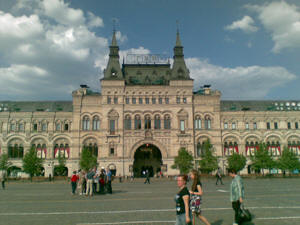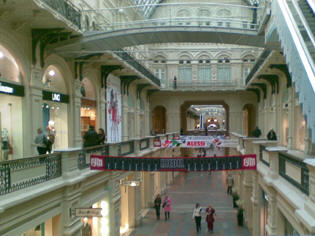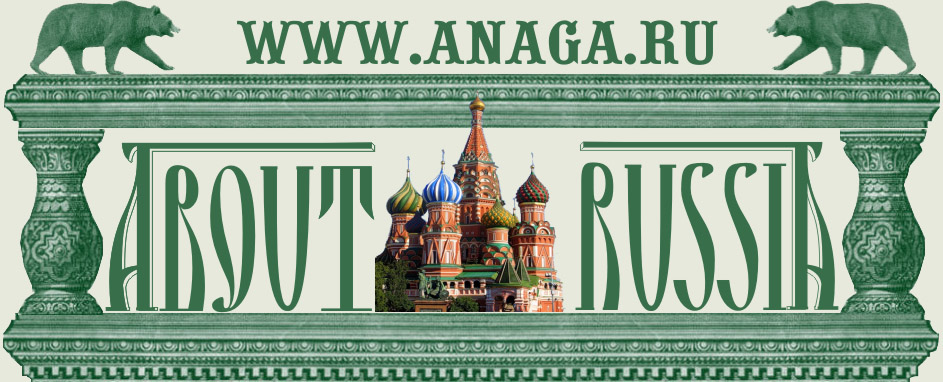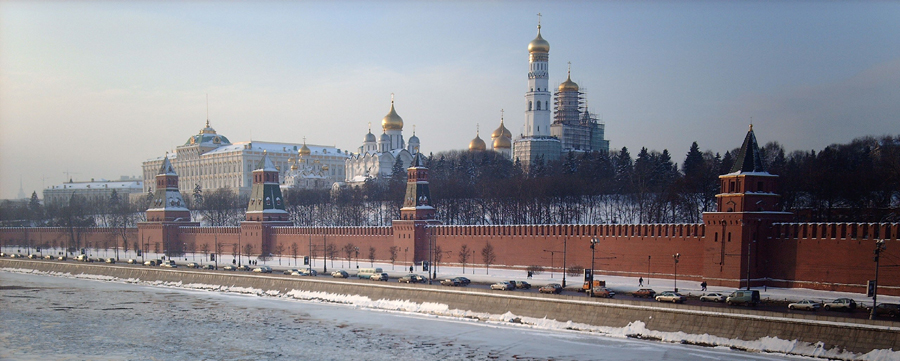|

GUM is a large depsrment store in Kitai-gorod of Moscow, facing
Red Square.


Modern GUM and Upper Trading Rows 100 years ago

Inside modern GUM and Upper Trading Rows 100 years ago

 |
GUM
(Main
Department Store)

GUM (ГУМ, pronounced as goom, in full Главный Универсальный Магазин, Glavnyi Universalnyi Magazin, meaning "main department store") is the name of the principal department store in many cities of the former Soviet Union, known as State Department Store Государственный Универсальный Магазин, Gosudarstvennyi Universalnyi Magazin) in the Soviet times. Similar-named stores were in the some Soviet republics and post-Soviet states. The most famous GUM is a large store in Kitai-gorod of Moscow, facing Red Square. It is actually a shopping mall. Prior to the 1920s the place was known as the Upper Trading Rows (Верхние торговые ряды).

With the façade extending for 242 m (794 ft) along the eastern side of Red Square, the Upper Trading Rows were built between 1890 and 1893 by Alexander Pomerantsev (responsible for architecture) and Vladimir Shukhov (responsible for engineering). The trapezoidal building features an interesting combination of elements of Russian medieval architecture and a steel framework and glass roof, a similar style to the great Victorian train stations of London. Nearby, also facing Red Square, is a very similar building, formerly known as the Middle Trading Rows.The east side of the Kremlin triangle, lying adjacent to Red Square and situated between the rivers Moskva and the now-underground Neglinnaya River was deemed the most vulnerable side of the Kremlin to attack, since it was neither protected by the rivers, nor any other natural barriers, as the other sides were. Therefore, the Kremlin wall was built to its highest height on this side, and furthermore, the Italian architects involved in the building of these fortifications convinced Ivan the Great to clear the area outside of the walls in order to create a field of fire for shooting. The relevant decrees were issued in 1493 and 1495. They called for the demolition of all the buildings within 110 sazhens (234 metres) of the wall.
 The existing structure — defined by William Craft Brumfield as "a tribute both to Shukhov's design and to the technical proficiency of Russian architecture toward the end of the 19th century" — was built to replace the previous trading rows that had burnt down in 1825. The glass-roof designed made the building unique at the time of construction. The roof, whose diameter is 14 m (46 ft), looks light, but it is a firm construction made of over 50,000 metal pods (about 819 short tons (743 t), capable of supporting snowfall accumulation. Illumination is provided by huge arched skylights of iron and glass, each weighing some 820 short tons (740 t) and containing in excess of 20,000 panes of glass. The facade is split into several horizontal tiers, lined with red Finnish granite, Tarusa marble, and limestone. Each arcade is on three levels, linked by walkways of reinforced concrete. The existing structure — defined by William Craft Brumfield as "a tribute both to Shukhov's design and to the technical proficiency of Russian architecture toward the end of the 19th century" — was built to replace the previous trading rows that had burnt down in 1825. The glass-roof designed made the building unique at the time of construction. The roof, whose diameter is 14 m (46 ft), looks light, but it is a firm construction made of over 50,000 metal pods (about 819 short tons (743 t), capable of supporting snowfall accumulation. Illumination is provided by huge arched skylights of iron and glass, each weighing some 820 short tons (740 t) and containing in excess of 20,000 panes of glass. The facade is split into several horizontal tiers, lined with red Finnish granite, Tarusa marble, and limestone. Each arcade is on three levels, linked by walkways of reinforced concrete.
 By the time of the Russian Revolution of 1917, the building contained some 1,200 stores. After the Revolution, the GUM was nationalised and continued to work as a department store until Joseph Stalin turned it into office space in 1928 for the committee in charge of his first Five Year Plan. After the suicide of Stalin's wife Nadezhda in 1932, the GUM was used to display her body.
After reopening as a department store in 1953, the GUM became one of the few stores in the Soviet Union that was not plagued by shortages of consumer goods, and the queues to purchase anything were long, often extending all across Red Square.
At the end of the Soviet era, GUM was partially then fully privatized, and it passed through a number of owners before it ended up in the hands of the supermarket chain Perekryostok. In May 2005, a 50.25% interest was sold to Bosco di Ciliegi, a Russian luxury-goods distributor and boutique operator. As a private shopping mall, it was renamed in such a fashion that it could maintain its old abbreviation and still be called GUM. The first word "Gosudarstvennyj" has been replaced with "Glavnyj" (Rus. Главный) 'main', so that GUM is now an abbreviation for "Main Department Store".
It is still open today, and is a popular tourist destination for those visiting Moscow. Many of the stores feature high-fashion brand names familiar in the West; locals refer to these as the "exhibitions of prices", the joke being that no one could afford to actually buy any of the items on display. As of 2005, there were approximately 200 stores.
There is a similar historic department store that rivals GUM in size, elegance and opulent architecture called Central Department Store (Tsentralniy Universalniy Magazin, abbreviated as TsUM). It sprawls just east of the Bolshoi Theatre. By the time of the Russian Revolution of 1917, the building contained some 1,200 stores. After the Revolution, the GUM was nationalised and continued to work as a department store until Joseph Stalin turned it into office space in 1928 for the committee in charge of his first Five Year Plan. After the suicide of Stalin's wife Nadezhda in 1932, the GUM was used to display her body.
After reopening as a department store in 1953, the GUM became one of the few stores in the Soviet Union that was not plagued by shortages of consumer goods, and the queues to purchase anything were long, often extending all across Red Square.
At the end of the Soviet era, GUM was partially then fully privatized, and it passed through a number of owners before it ended up in the hands of the supermarket chain Perekryostok. In May 2005, a 50.25% interest was sold to Bosco di Ciliegi, a Russian luxury-goods distributor and boutique operator. As a private shopping mall, it was renamed in such a fashion that it could maintain its old abbreviation and still be called GUM. The first word "Gosudarstvennyj" has been replaced with "Glavnyj" (Rus. Главный) 'main', so that GUM is now an abbreviation for "Main Department Store".
It is still open today, and is a popular tourist destination for those visiting Moscow. Many of the stores feature high-fashion brand names familiar in the West; locals refer to these as the "exhibitions of prices", the joke being that no one could afford to actually buy any of the items on display. As of 2005, there were approximately 200 stores.
There is a similar historic department store that rivals GUM in size, elegance and opulent architecture called Central Department Store (Tsentralniy Universalniy Magazin, abbreviated as TsUM). It sprawls just east of the Bolshoi Theatre.
 See
the location of the Moscow free restrooms on the map. See
the location of the Moscow free restrooms on the map.
See
also:

Moscow in pictures
 Moscow
Moscow

How to use Moscow Metro
 Moscow ground public transport
Moscow ground public transport
 Red Square
Red Square
 GUM
GUM
|







 The existing structure — defined by William Craft Brumfield as "a tribute both to Shukhov's design and to the technical proficiency of Russian architecture toward the end of the 19th century" — was built to replace the previous trading rows that had burnt down in 1825. The glass-roof designed made the building unique at the time of construction. The roof, whose diameter is 14 m (46 ft), looks light, but it is a firm construction made of over 50,000 metal pods (about 819 short tons (743 t), capable of supporting snowfall accumulation. Illumination is provided by huge arched skylights of iron and glass, each weighing some 820 short tons (740 t) and containing in excess of 20,000 panes of glass. The facade is split into several horizontal tiers, lined with red Finnish granite, Tarusa marble, and limestone. Each arcade is on three levels, linked by walkways of reinforced concrete.
The existing structure — defined by William Craft Brumfield as "a tribute both to Shukhov's design and to the technical proficiency of Russian architecture toward the end of the 19th century" — was built to replace the previous trading rows that had burnt down in 1825. The glass-roof designed made the building unique at the time of construction. The roof, whose diameter is 14 m (46 ft), looks light, but it is a firm construction made of over 50,000 metal pods (about 819 short tons (743 t), capable of supporting snowfall accumulation. Illumination is provided by huge arched skylights of iron and glass, each weighing some 820 short tons (740 t) and containing in excess of 20,000 panes of glass. The facade is split into several horizontal tiers, lined with red Finnish granite, Tarusa marble, and limestone. Each arcade is on three levels, linked by walkways of reinforced concrete.
 By the time of the Russian Revolution of 1917, the building contained some 1,200 stores. After the Revolution, the GUM was nationalised and continued to work as a department store until Joseph Stalin turned it into office space in 1928 for the committee in charge of his first Five Year Plan. After the suicide of Stalin's wife Nadezhda in 1932, the GUM was used to display her body.
After reopening as a department store in 1953, the GUM became one of the few stores in the Soviet Union that was not plagued by shortages of consumer goods, and the queues to purchase anything were long, often extending all across Red Square.
At the end of the Soviet era, GUM was partially then fully privatized, and it passed through a number of owners before it ended up in the hands of the supermarket chain Perekryostok. In May 2005, a 50.25% interest was sold to Bosco di Ciliegi, a Russian luxury-goods distributor and boutique operator. As a private shopping mall, it was renamed in such a fashion that it could maintain its old abbreviation and still be called GUM. The first word "Gosudarstvennyj" has been replaced with "Glavnyj" (Rus. Главный) 'main', so that GUM is now an abbreviation for "Main Department Store".
It is still open today, and is a popular tourist destination for those visiting Moscow. Many of the stores feature high-fashion brand names familiar in the West; locals refer to these as the "exhibitions of prices", the joke being that no one could afford to actually buy any of the items on display. As of 2005, there were approximately 200 stores.
There is a similar historic department store that rivals GUM in size, elegance and opulent architecture called Central Department Store (Tsentralniy Universalniy Magazin, abbreviated as TsUM). It sprawls just east of the Bolshoi Theatre.
By the time of the Russian Revolution of 1917, the building contained some 1,200 stores. After the Revolution, the GUM was nationalised and continued to work as a department store until Joseph Stalin turned it into office space in 1928 for the committee in charge of his first Five Year Plan. After the suicide of Stalin's wife Nadezhda in 1932, the GUM was used to display her body.
After reopening as a department store in 1953, the GUM became one of the few stores in the Soviet Union that was not plagued by shortages of consumer goods, and the queues to purchase anything were long, often extending all across Red Square.
At the end of the Soviet era, GUM was partially then fully privatized, and it passed through a number of owners before it ended up in the hands of the supermarket chain Perekryostok. In May 2005, a 50.25% interest was sold to Bosco di Ciliegi, a Russian luxury-goods distributor and boutique operator. As a private shopping mall, it was renamed in such a fashion that it could maintain its old abbreviation and still be called GUM. The first word "Gosudarstvennyj" has been replaced with "Glavnyj" (Rus. Главный) 'main', so that GUM is now an abbreviation for "Main Department Store".
It is still open today, and is a popular tourist destination for those visiting Moscow. Many of the stores feature high-fashion brand names familiar in the West; locals refer to these as the "exhibitions of prices", the joke being that no one could afford to actually buy any of the items on display. As of 2005, there were approximately 200 stores.
There is a similar historic department store that rivals GUM in size, elegance and opulent architecture called Central Department Store (Tsentralniy Universalniy Magazin, abbreviated as TsUM). It sprawls just east of the Bolshoi Theatre.

